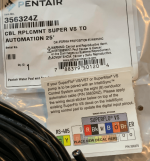My pool had a single speed 2HP pump that just recently died. My pool also has solar panel and a Hayward Aqua Solar GL-235 controller. I'm not the original owner of the house who installed these equipment. In the past 2 years I've own the house, I just set the desired temperature on the solar controller and never have to mess with it and never gotten air bubble in the pool return with the single speed pump. I've just replaced the pump with the Pentair VS SuperFLO. The pool store owner and installer said it should be enough to pump water up my solar panel even at slower speed. It's listed at 1.5HP but the installer said it's has 2.2HP. Previously, I believe my pool timer would turn on/off both the single speed pump and the solar controller at the same time. However, with the new install, the VS pump is no longer driven by the pool timer and only the solar controller is.
I noticed when the VS pump is running at slower speed, I'm getting a lot of bubble in the pool return that does not go away even after running for hours. I also hear the bubbling sound in the pipe going up the solar panel. When I increase the RPM to 2900, the bubbles stop. Also, if I bypass the solar panel, even at slower speed there is no bubble. Some how running at slower speed introduces bubbles into the pool return. I am okay with running the VS pump at 2900 RPM to not have bubbles in the system. However if I run it at that constant speed or higher, I feel like I'm not making use of the energy save of using a VS pump by running at slower speed especially if I want to run it at night.
The installer has set my pool timer to turn on/off the solar controller to be on the same schedule as the VS pump running all 3 schedules( there are a total of 3 schedules that it runs everyday). But unless all 3 schedules are running at 2900 RPM or faster, I get air bubbles in the system.
So a few questions I have are:
1) Is there any harm in having air bubble in the system, especially in the solar panel?
2) Should the pool timer still turn on/off the solar controller? Or should I just let the solar controller run 24/7? Because when the solar controller is turned off, the bypass valve doesn't get rotated.
3) Is there a way I can get the solar controller to turn on the bypass valve if it recognizes that the VS pump is running at slower speed?
I noticed when the VS pump is running at slower speed, I'm getting a lot of bubble in the pool return that does not go away even after running for hours. I also hear the bubbling sound in the pipe going up the solar panel. When I increase the RPM to 2900, the bubbles stop. Also, if I bypass the solar panel, even at slower speed there is no bubble. Some how running at slower speed introduces bubbles into the pool return. I am okay with running the VS pump at 2900 RPM to not have bubbles in the system. However if I run it at that constant speed or higher, I feel like I'm not making use of the energy save of using a VS pump by running at slower speed especially if I want to run it at night.
The installer has set my pool timer to turn on/off the solar controller to be on the same schedule as the VS pump running all 3 schedules( there are a total of 3 schedules that it runs everyday). But unless all 3 schedules are running at 2900 RPM or faster, I get air bubbles in the system.
So a few questions I have are:
1) Is there any harm in having air bubble in the system, especially in the solar panel?
2) Should the pool timer still turn on/off the solar controller? Or should I just let the solar controller run 24/7? Because when the solar controller is turned off, the bypass valve doesn't get rotated.
3) Is there a way I can get the solar controller to turn on the bypass valve if it recognizes that the VS pump is running at slower speed?


